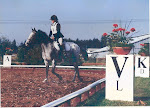A growing contingent of hoof-care experts says yes. Here's what the natural-foot movement could mean for your horse.
By Jennifer Forsberg Meyer
The barefoot option. You've heard of it, but you know it's not for your horse, because (pick one or more):
it's a fad.
he has bad feet.
you ride on rugged ground.
you show.
You agree that going barefoot is healthy for a hoof, and that pulling a horse's shoes at least once a year to reestablish natural hoof growth is a good thing. But eventually those shoes must go back on, right? Permanent barefootedness is appropriate only for certain horses who already have tough, resilient hooves.
Right?
Four months ago, I'd have agreed with you on all of the above. But now I'm not so sure. By researching this article, I've learned amazing things about how a horse's hoof is designed to function. As a result, I'm beginning to understand why a growing number of natural hoof-care experts say barefoot is not just for horses with already-excellent hooves.
In fact, judging by the evidence, the opposite may be true. Going barefoot (as the result of a correct trim and combined with compatible living conditions) may be the way to make bad hooves better, and even excellent. It may also create hooves capable of supporting a horse--with rider--over most types of terrain. And (this is the most intriguing part) it may enhance a horse's overall health, comfort, and longevity.
What I learned, in fact, prompted me to consider the barefoot lifestyle for my own horses, who live and are sometimes ridden on hard, rocky ground.
In this article, I'll explain what I found so compelling. I'll tell how the barefoot movement began, share the thinking of some of its most prominent advocates, and detail what's necessary to make the barefoot option work. I'll also discuss an alternative approach that applies natural-foot principles to a nontraditional shoe.
In short, I'll give you the tools you need to decide if new-age foot care is something you want to pursue for your own horse.
As Nature Intended
The foundation for a natural approach to hoof care was laid 20 years ago primarily by the work of two farriers. Jaime Jackson and Gene Ovnicek independently conducted field research among feral mustangs in the mid-1980s. Each hoped to see what the hooves and habits of horses in the wild might tell us about foot care for the domestic horse.
Both were astonished at the hardiness and resilience of the feet they saw. Without metal shoes to restrict elasticity and contact with the ground, the mustangs' feet remained tough and healthy even traveling at speed over the roughest ground. Lameness was rare, and usually accident-related rather than caused by disease of the hoof itself.
The mustangs' feet were heavily callused across the toe. Ovnicek's research showed that, contrary to popular belief, the hoof wall is not the primary weight-bearing surface. Rather, the load is shared among the sole, bars, frog, and wall.
"Intuitively, it always seemed to make sense that the hoof wall is the weight-bearer,"says Ovnicek today."And that belief kept us stuck in old modes of shoeing."
In the 20 years since the first feral-horse research, interest in natural methods of increasing the hoof health of domestic horses has blossomed around the world. Jackson has gone on to write several books related to the topic. He also helped create the American Association of Natural Hoof Care Practitioners, which promotes research and trains/certifies professionals.
Ovnicek, who still supports the ideal of "barefoot where possible,"has gone on to develop an innovative shoe that takes the natural functioning of the equine foot into account. He also lectures and provides clinics around the world on what he calls the "natural balance" of the equine foot.
Veterinarians, research centers, and universities are increasingly taking notice of the natural hoof 's powers to prevent and in many cases cure diseases like laminitis and navicular. Moreover, word of mouth among horse owners is building demand for more information on natural hoof care and access to practitioners.
Just before I began work on this article, I heard an enthusiastic endorsement of the barefoot trim from my neighbor, who's pleased with the results she's getting with her laminitic gelding. That caused me to wonder: Just how does it all work?
The Underlying Science
Robert Bowker, VMD, PhD is a leading researcher in the natural function of the equine foot. A neurobiologist who teaches anatomy at Michigan State University, he became interested in foot function about 10 or 12 years ago, when students asked him about the correct placement of nerve blocks. The anatomy texts he check were incorrect, so he began examining the equine foor himself.
His research extended from the nerves of the foot to the blood vessels, cartilage, and bones, and more recently to the hooves and their laminae in health and disease.He supplemented his lab work with observations of free-roaming feral horses.
click to read the rest of the article with pictures.....
About EquiSearch.com | Advertise | Privacy Policy | Customer Service | Site Map
© 2008, EquiSearch.com, SOURCE INTERLINK MEDIA, INC. All rights reserved.
I don't teach about horses, the horses do the teaching...if only we would listen to them.

Donna DeNoble
Monday, February 11, 2008
Subscribe to:
Post Comments (Atom)







No comments:
Post a Comment